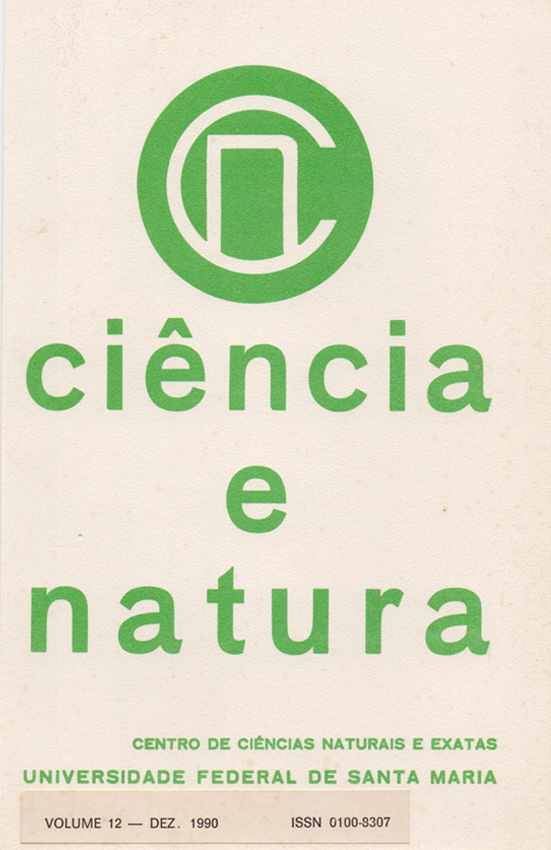Estudo anatômico da madeira de Myrceugenia glaucescens (Camb.) Legr. et Kaus
DOI:
https://doi.org/10.5902/2179460X25489Resumo
A madeira de Myrceugenia glaucescens é descrita em seus aspectos gerais e microscópicos. São fornecidos dados quantitativos e fotomicrografias de detalhes anatômicos. A estrutura miscroscópica é comparada com referências da literatura para a espécie, gênero e família Myrtaceae. Os caracteres mais importantes da madeira em estudo são a presença de placas de perfuração dos tipos simples, escalariforme e reticulada, pontuações raio-vasculares alongadas radialmente, e espessamentos espiralados em elementos vasculares bem como nos relativamente escassos traqueóides vasicêntricos. Raios de tipo heterogêneos - I, elemnetos vasculares longos, parênquima apotraqueal, fibrotraqueóides, pontuações ornamentadas e poros solitários, são também importantes detalhes anatômicos da madeira, mas com larga ocorrência na família.
Downloads
Referências
CABRERA, A.L. & ZARDINI, E.M. Manual de la Flora de los alrededores de Buenos Aires. Buenos Aires, Ed. ACHE S.A.C. I., 1978, 755 p.
CARLQUIST, S. Wood anatomy of Illicium (Illiciaceae). Phylogenetic, ecological and functional interpretations. American Journal of Botany, 1982, 70: 1578-1598.
COMISION PANAMERICANA DE NORMAS TECNICAS. 30: 1-019, novembro,1973.
LEGRAND, D. Las Mirtãceas del Uruguay, II. Comunicaciones botanicas del Museo de Historia Natural de Montevideo. 1(7): 1-11,1943.
LEGRAND, D. Nota preliminar sobre las especies de Myrceugenia austrobrasilenas. Comunicaciones botanicas del Museo de Historia Natural de Montevideo. Bol. nº 28, 1953. 13 p.
LEGRAND, D. Las Mirtáceas del Uruguay, III. Facultad de Agronomia de Montevideo. Bol. 101:3-80, 1968.
LEGRAND, D. & KLEIN, R.M. Mirtãceas. Flora Ilustrada Catarinense. Itajai, 1970. 333-453.
LOMBARDO, A. Flora arborea y arborescente del Uruguay. Montevideo, Concejo Departamental, 1964. 151 p.
MARCHIORI, J.N.C. Estudo anatômico do xilema secundário de algumas espécies dos gêneros Acacia e Mimosa, nativas no Estado do Rio Grande do Sul Curitiba, 1980. 186 p. Dissertação. Mestrado. Universidade Federal do Paraná. Setor de Ciências Agrárias. Curso de Pós-Graduação em Engenharia Florestal.
METCALFE, C.R. & CHALK, L. Anatomy of the Dieotyledons. Oxford, Clarendon Press, 1972. 1500 p.
MUÑIZ, G.I.B. de. Descrição da estrutura e ultraestrutura da madeira de cinco espécies de Prosopis da Argentina e análise da metodologia. Curitiba, 1986. 192 p. Dissertação. Mestrado. Universidade Federal do Paraná. Setor de Ciências Agrárias. Curso de Pós-Graduação em Engenharia Florestal.
RECORD, S.J. & HESS, R.W. Timbers of the New World. New Haven, Yale University Press, 1943. 640 p.
SCHMID, R. & BAAS, P. The occurrence of scalariform perforation plates and helical vessel wall thickenings in wood of Myrtaceae. IAWA Bulletin, 1984, 5(3): 197-215.
Downloads
Publicado
Como Citar
Edição
Seção
Licença
Para acessar a DECLARAÇÃO DE ORIGINALIDADE E EXCLUSIVIDADE E CESSÃO DE DIREITOS AUTORAIS clique aqui.
Diretrizes Éticas para Publicação de Revistas
A revista Ciência e Natura está empenhada em garantir a ética na publicação e na qualidade dos artigos.
A conformidade com padrões de comportamento ético é, portanto, esperada de todas as partes envolvidas: Autores, Editores e Revisores.
Em particular,
Autores: Os Autores devem apresentar uma discussão objetiva sobre a importância do trabalho de pesquisa, bem como detalhes e referências suficientes para permitir que outros reproduzam as experiências. Declarações fraudulentas ou intencionalmente incorretas constituem comportamento antiético e são inaceitáveis. Artigos de Revisão também devem ser objetivos, abrangentes e relatos precisos do estado da arte. Os Autores devem assegurar que seu trabalho é uma obra totalmente original, e se o trabalho e / ou palavras de outros têm sido utilizadas, isso tem sido devidamente reconhecido. O plágio em todas as suas formas constitui um comportamento publicitário não ético e é inaceitável. Submeter o mesmo manuscrito a mais de um jornal simultaneamente constitui um comportamento publicitário não ético e é inaceitável. Os Autores não devem submeter artigos que descrevam essencialmente a mesma pesquisa a mais de uma revista. O Autor correspondente deve garantir que haja um consenso total de todos os Co-autores na aprovação da versão final do artigo e sua submissão para publicação.
Editores: Os Editores devem avaliar manuscritos exclusivamente com base no seu mérito acadêmico. Um Editor não deve usar informações não publicadas na própria pesquisa do Editor sem o consentimento expresso por escrito do Autor. Os Editores devem tomar medidas de resposta razoável quando tiverem sido apresentadas queixas éticas relativas a um manuscrito submetido ou publicado.
Revisores: Todos os manuscritos recebidos para revisão devem ser tratados como documentos confidenciais. As informações ou ideias privilegiadas obtidas através da análise por pares devem ser mantidas confidenciais e não utilizadas para vantagens pessoais. As revisões devem ser conduzidas objetivamente e as observações devem ser formuladas claramente com argumentos de apoio, de modo que os Autores possam usá-los para melhorar o artigo. Qualquer Revisor selecionado que se sinta desqualificado para rever a pesquisa relatada em um manuscrito ou sabe que sua rápida revisão será impossível deve notificar o Editor e desculpar-se do processo de revisão. Os Revisores não devem considerar manuscritos nos quais tenham conflitos de interesse resultantes de relacionamentos ou conexões competitivas, colaborativas ou outras conexões com qualquer dos autores, empresas ou instituições conectadas aos documentos.






